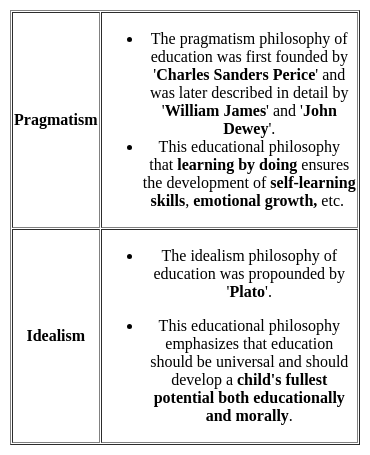UGC NET Paper 2 Education Mock Test - 2 - UGC NET MCQ
30 Questions MCQ Test UGC NET Mock Test Series 2024 - UGC NET Paper 2 Education Mock Test - 2
Basic feature of constitution of India is to deepen the:
| 1 Crore+ students have signed up on EduRev. Have you? Download the App |
The following statements are either True or False. Choose the correct statement from the codes given below :
(a) Emotions are associated with instincts.
(b) Emotional expressions are same in all persons.
(c) Emotions involve physical changes in persons.
(d) Maturation plays an important role in emotional development.
Read the following statements and choose the appropriate option.
Assertion: Child-centered education is an approach that prioritizes the interests and needs of the child over those of the teacher or curriculum.
Reason: Progressive education is an approach that emphasizes active learning, critical thinking, and problem-solving skills rather than memorization and rote learning.
What is Sri Prakasa Committee (1959) most commonly known for?
Many experienced teachers go into a classroom and embark straight away upon a lesson. As a beginner to the teaching profession will you
The rate of habituation is an indication of:
The mid-day meal programme for Pr. Schools was initiated with a view to
Which university was given the level of a complete university?
Assertion (A): Learning is the sequence of events that we recall for long period, it offers behavioral changes which are permanent.
Reasoning (R): Learning can not be defined as temporary change in behavior and can occur as a result of prior experience.
Which of the following set of statements best represents the nature and objective of teaching and learning ?
(a) Teaching is like selling and learning is like buying.
(b) Teaching is a social act while learning is a personal act.
(c) Teaching implies learning whereas learning does not imply teaching.
(d) Teaching is a kind of delivery of knowledge while learning is like receiving it.
(e) Teaching is an interaction and is triadic in nature whereas learning is an active engagement in a subject domain.
What is the name of process used by the educators to identify the learning disability?
Which school of Philosophy in education will plead affinity with Darwinian theory of evaluation?
The Ramamurti Review Committee recommended that admission to higher education must be
Teaching by small steps and frequent short assignment techniques are useful for
1) Slow learners
2) Learning disabled
3) Educationally backward children
4) Children of all types of disabilities
Which of the following is not a factor affecting the infrastructure and resources of higher education institutions in India?
The National flagship programme of education (SSA) aims at
Which of the following is not a form of virtual learning?
|
16 docs|120 tests
|




















